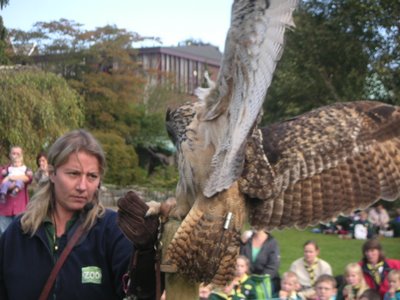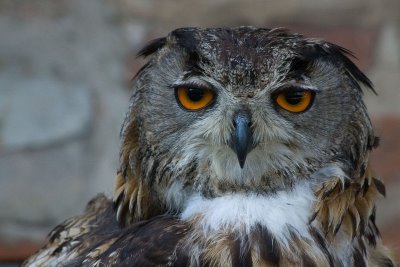Animal Encounters XII

The Eagle Owl is a species of horned owl resident in much of Europe and Asia. It is a very large and powerful bird, but despite its name it is generally smaller than for instance the Golden Eagle. It is the largest species of owl with a wingspan of up to 2m. Adults can weigh in excess of 4 kg, in comparison the common Barn Owl weighs about 500 g. It mainly feeds on small mammals but will take prey up to the size of foxes and young deer. It will also take many other birds including other birds of prey.
Silent and stealthy flight
It is largely nocturnal and is found in mountains and forests with cliffs and rocky areas. It usually nests on cliff ledges. They live for around 20 years although like many other bird species in captivity they can live much longer, perhaps up to 60 years. The calls of the Eagle Owl is a deep resonant “ooh-hu” with emphasis on the first syllable for the male, and a more high-pitched uh-Hu for the female. A recent study has shown that these calls are easily individualized. It means that each member of an Eagle Owl population can be individually identified by means of its vocalizations.
Landing gear
The size, ear tufts and orange eyes make this a very distinctive species. It has a strong direct flight. The horned owls are a part of the larger grouping of owls known as the typical owls, Strigidae, which contains most species of owl. The other grouping is the barn owls, Tytonidae.
The Eagle Owl is not naturally resident in England, but (ref. a BBC TV program) a pair have been breeding for several years in a valley in Ministry of Defence land in North Yorkshire. There is some debate as to whether these birds are escapees or whether they have arrived naturally from the continent which would only be a relatively short journey. At the time the program was made, they had reared 20 young to independence, and they had 3 young in the nest. Nothing was known of what happened to those 20 young, except that one of them electrocuted itself on power lines in Shropshire.

Check out those cool ear tuffs!
The Eagle Owl's scientific name comes from its deep booming call. The word "bubo," based on the call, has referred to owls, particularly the Eagle Owl, since the dark ages, and is mentioned in Middle English bestiaries. The difference between the male and female is very recognisable as the male's ear tufts are more upright than the female's, while hers are usually drooping down.
Hey there sexy!
So thats it for today folks, join me next week for another interesting episode of Animal Encounters!





0 Comments:
Post a Comment
<< Home